Introduction
The coronacrisis is over, right? A barrage of quantitative easing and money creation from central banks, unprecedented fiscal stimulus across the developed world and voila! – credit spreads begin to tighten as markets start to price in a global recovery.
But simply because credit spreads are tightening does not mean the default cycle is fully played out. Indeed, we would argue the reverse. As government stimulus packages roll off and the full effect of output gap starts to be felt, we may well see the second act of the coronacrisis – a further wave of defaults building throughout late 2020 and into 2021.
In our view, the coronacrisis will cause a surge in default, distress or insolvency for companies globally, and these companies will vary greatly in quality from the point of view of a distressed debt investor. Attractive opportunities presented by ‘good’ companies with ‘bad’ balance sheets undergoing a temporary shock will be accompanied by a host of distressed securities in junior positions in the capital structures of over-levered, asset-light, discretionary businesses whose prospects may have been permanently impaired by the after-effects of the coronacrisis.
Most distressed funds are constrained to opportunities within a prescribed region (overwhelmingly the US or Europe).1 This constraint can force managers to operate within a saturated arena where returns on ‘good’ distressed credits can be quickly eroded away by stiff competition, and where managers may find themselves speculating on more risky positions in less attractive or less liquid propositions in order to generate their targeted returns.
A flexible approach with respect to geography and a selective approach with respect to the asset may allow managers to generate superior risk-adjusted returns by cherry picking the most attractive assets amidst a possible wave of distressed opportunities. Portfolio managers less constrained by geography can focus on buying distressed credits backed by strong assets, positioned attractively in the capital stack and with superior long-term cash-generation outlooks. Opportunities to invest in credits with these appealing characteristics tend to present themselves periodically throughout the cycle and across geographies to those with the flexibility to look for them.
The Second Default Wave
An underappreciated facet of the coronavirus compared with other recessions is the delayed timing of credit defaults and bankruptcies. This is explained by two factors: the unprecedented scale of monetary and fiscal policy deployed by governments in response to the crisis, and the extent to which government measures have delayed the legal process of insolvency and default.
Policymakers have enacted a wide range of measures to prevent bankruptcies and extend credit to troubled firms. Perhaps the most committed example has been the Federal Reserve, which immediately created the Primary Market Corporate Credit Facility (‘PMCCF’) and the Commercial Paper Funding Facility (‘CPFF’) to directly purchase both corporate bonds and commercial paper to ensure US companies could access credit across the yield curve to avoid immediate default. In tandem, the US government signed the Coronavirus Aid, Relief, and Economic Security (‘CARES’) Act to provide similar financing to small- and medium-sized enterprises, with the initial size of the US bailout worth USD2 trillion.2 Other governments have provided similar bailouts: Germany with EUR130 billion3, the UK at GBP123 billion4, and Japan with 108 trillion yen.5
The fiscal response in emerging-market (‘EM’) economies has so far been more muted compared to developed-market (‘DM’) economies (Figure 1), in part because the pandemic unfolded later in EM, but also because of more limited fiscal space. EMs entered the crisis with weaker public balance sheets than before the Global Financial Crisis (‘GFC’), and a rise in the cost of external funding following a capital retrenchment by international investors further limited the capacity for fiscal stimulus. As has been written previously, EMs must also act with more restraint than DMs when using monetary stimulus measures such as quantitative easing; while this can provide short-term relief, the currency markets can quickly punish an emerging economy that is perceived to be committed to monetary financing of an unsustainable budget deficit. Nonetheless, the fiscal actions of governments globally have acted as an effective stopgap measure in the wake of some of the most severe GDP contractions in history.
Figure 1. DM and EM Fiscal Responses to Covid-19
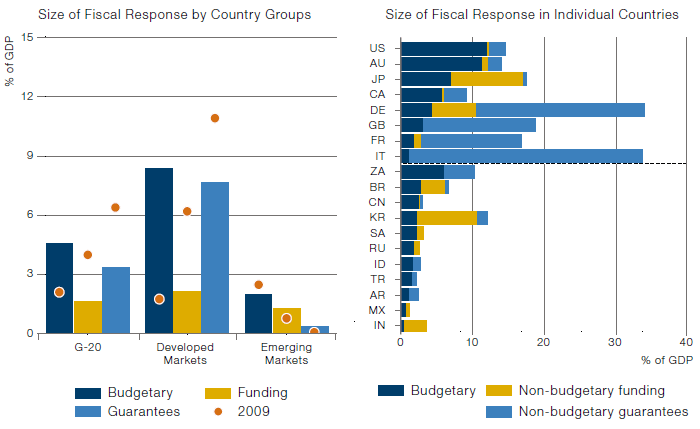
Source: Bank for International Settlements Bulletin No. 23.
Note: DMs: Australia, Canada, Denmark, France, Great Britain, Italy, Japan, US; EMs: Argentina, Brazil, China, Indonesia, India, South Korea, Mexico, Russia, South Africa, Turkey, Zambia.
The second factor in delaying defaults is a technical one. Countries such as France, Germany and the UK have altered their bankruptcy regimes: the former two nations suspended the obligation to file for bankruptcy until 30 September, 2020, while the UK introduced the Corporate Governance and Insolvency Act, which temporarily suspended wrongful trading provisions and introduced a moratorium of up to 40 days to allow firms to pursue rescue plans. In Brazil, debt collection activities against debtors in default were suspended for 60 days, during which period it was also illegal to declare a debtor bankrupt. Many countries have seen a reduction in the activities of business courts due to the pandemic, which has further slowed the rate of defaults.
However, whilst the rate of defaults has to date been depressed compared with the magnitude of the economic crisis, it does not mean that default risk has gone away. In the US, bankruptcies of listed companies have been steadily rising since March (Figure 2). In addition, insurance company Euler Hermes predict that their Global Insolvency Index will hit levels last seen in 2009 by the end of 2020, rising to a new high in 2021 (Figure 3).
Similarly, Moody’s expects the trailing 12-month default rate for global high yield credit in February 2021 to be between 9.7% and 13.3% (10.9%-14.5% for the US and 4.7%-8.9% for Europe)6, representing a similar number of issuers defaulting as following the GFC. The default rate for EM sovereigns has already reached 15.8% year-to-date, and EM corporate high yield default rates are expected to triple from 1.5% in 2019 to 4.5% by year-end 2020 according to JPMorgan.7
Quite simply, the demand gap created by coronavirus will be too big for many firms to overcome, despite accommodative monetary and fiscal policy.
Figure 2. Bankruptcies of Listed Companies in the US in 2020
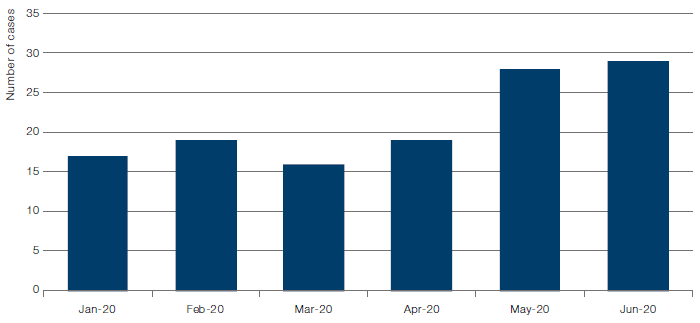
Source: Euler Hermes; as of 30 June 2020.
Figure 3. Euler Hermes Global Insolvency Index
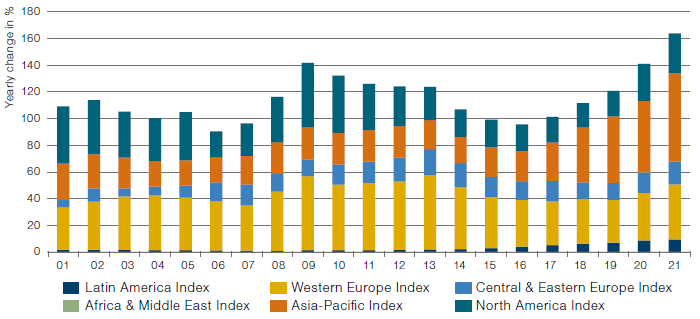
Source: Euler Hermes; as of 16 July 2020.
Flexible, Asset-Focused Deployment
With an expanding opportunity set, how should distressed investors best deploy their cash during the second act of the coronacrisis?
First, we believe it is important to weigh risk in the context of the value of the underlying business and its assets, rather than take a regional- or country-based approach. Although it is true that there will be differences in economic recoveries of different countries, investors should be cognisant of industry-specific factors that can outweigh country risk in a risk-return analysis.
An example of this is the European aviation sector. Whilst European countries such as Germany have so far had the smallest dip in GDP growth, this does not provide a guarantee that distressed airline credit will be less risky in the region. Most airlines lease their fleet, meaning that the operating model is asset-light, with very few tangible assets to sell. Often, the only assets available to creditors in a liquidation are the slots the airline has been allocated at major airports. Despite being in a region which is relatively less hard-hit, creditors could simply be left with the rights to the brand of a defunct airline, and some terminal slots. Furthermore, with the imposition and re-imposition of quarantines, the underlying ability of airlines to earn their way out of trouble is questionable without significant government bailouts. Thus, a seemingly less-risky region can actually pose something of a trap for unwary investors if not enough consideration is paid to company-specific risk.
Instead of a geographically deterministic assessment of risk, we believe investors are best served by a multivariate risk assessment. ‘Good’ borrowers are found in a variety of geographies and combine a willingness and capacity to pay. These businesses tend to meet one of two criteria: either owning an asset base with residual value, or having a business model with short-term liquidity problems, but a proven ability to generate cash through the cycle.
Again, it is important to consider the underlying dynamics of the business when valuing an asset base. For instance, the coronacrisis has had a deleterious effect on the global cement market. Many countries saw shutdowns of their building sector, creating cashflow problems for many operators. Cement is also difficult to store and transport, which meant that a shutdown forced a number of inventory write-offs. Nevertheless, from the perspective of a distressed investor, it is the very difficulty of transport and storage which makes the sector attractive. Most cement is sold locally, with plants strategically located near their biggest markets. This means that much of the sector’s plant assets have a residual value. Even in a sharp downturn, because it is not efficient to import cement, if competitors wish to enter a new market, they are almost always forced to buy an existing plant in-country, thus protecting the value of existing plants and the assets of distressed firms.
Furthermore, barriers to entry including the highly local nature of cement markets means that fears of regional risk can be somewhat assuaged, with freight costs prohibiting entry by global firms without a local presence. Put simply, even the riskiest emerging market is likely to rely on a local plant to produce its cement. With this in mind, if assets have value, investors should embrace opportunities which fall outside traditionally ‘safer’ geographies.
Figure 4. Traded Volumes as % of Global Production
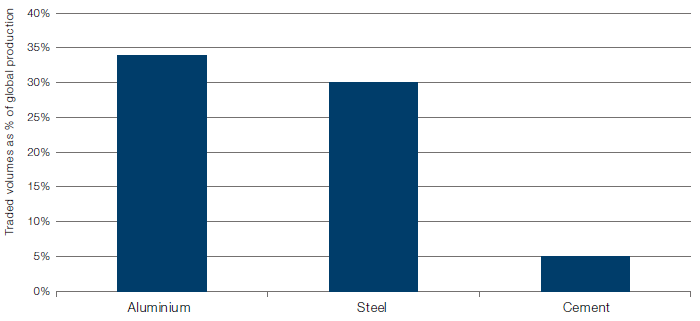
Source: Morgan Stanley Report on European Cement; as of 2018.
The other key factor is the ability of distressed businesses to generate cashflow to pull themselves out of trouble. Whilst the value of a firm’s assets can often be reflected in the price, even after debt covenants have been breached and bonds are in default, assessing the ability of a firm to generate cash throughout the cycle can often allow investors to identify undervalued businesses which are simply going through short-term liquidity issues. Indeed, a general climate of panic can often mask the fact that many businesses in default would continue to be going concern if liquidity more readily available. An example can be found in Ukraine’s electricity generation sector.
Ukraine’s electricity generation sector is under distress due to, amongst other factors, reduced demand in the wake of Covid-19 and double-digit depreciation of the Ukrainian hryvnia since January 2020. While local currency revenues have decreased due to suppressed demand and power prices, the sector’s US dollar-denominated liabilities have increased in terms of its revenue-generating currency and the resulting liquidity crisis rendered some operators in the sector unable to meet their foreign liabilities. However, the electricity market in Ukraine is highly concentrated amongst a few large players that own substantial, systemic assets which all but ensures their status as a going concern in the near term. Furthermore, it is a political priority in all countries to ensure the smooth functioning of the power sector, so it is reasonable to expect some beneficial state intervention for these businesses in times of distress. Finally, the effect of currency depreciation can eventually be mitigated through inflationary pressures on the power prices. Acquiring a claim on assets that are essential to the functioning of an industrial economy at sufficiently depressed prices due to a liquidity issue offers, in our view, an attractive risk-return profile.
Figure 5. Ukraine’s Concentrated Power Sector
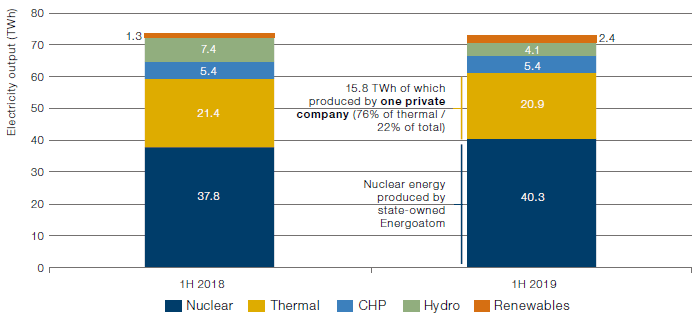
Source: Ukraine Ministry of Energy and Environment; as of 31 December 2019.
More generally, systemic borrowers that generate revenue locally in sectors such electricity, infrastructure and telecoms can often present attractive opportunities in the midst of a currency or economic crisis. By their systemic nature, they tend to recover from economic crises and they can catch up following currency blow-outs through inflationary pressures on pricing.
In our view, attractive opportunities can also be found in export sectors in countries with a depreciating currency. For example, Brazil’s iron ore and steel sector prices its exports in dollars and is effectively hedged with regards to its USD-denominated liabilities. Instead, the sector has benefited from the Brazilian real’s depreciation against the dollar as, all else being equal, its cost base in terms of its liability currency is reduced by the amount the local currency has depreciated. As exporting sectors go through their own capacity or capital cycles, attractive opportunities can be found in distressed bottom-quartile cash-cost producers that are able to weather a fall in prices and are first to return to full capacity after the cycle bottoms out.
Conclusion
Despite a growing sense of optimism, we expect to see a second act in the coronavirus default cycle. Whilst the policy response to the crisis has prevented an immediate spate of bankruptcies, there is a limit to how long central banks and governments can hold back the tide.
As the range of opportunity grows for distressed investors, we are mindful that the basics do not change. By focusing on debt backed by strong assets and the potential for cashflow generation, we feel investors will put themselves in the best position to ride out the coming default wave.
1. Source: Preqin Spotlight; 17 June 2020.
2. Source: BBC; Coronavirus: Trump signs into law largest bailout in US history.
3. Source: Friends of Europe; Germany: Merkel’s €130bn COVID-19 bailout wins back electorate.
4. Source: Institute for Fiscal Studies; How does the size of the UK’s fiscal response to coronavirus compare with other countries?
5. Source: Nippon.com; Coronavirus: Japan Finalizes Unprecedented 108 Trillion Yen Coronavirus Stimulus.
6. Source: Moody’s; Past recessions indicate potential paths for default rate in current downturn.
7. Source: JPMorgan; EM Corporate Default Update; 27 August 2020.
You are now leaving Man Group’s website
You are leaving Man Group’s website and entering a third-party website that is not controlled, maintained, or monitored by Man Group. Man Group is not responsible for the content or availability of the third-party website. By leaving Man Group’s website, you will be subject to the third-party website’s terms, policies and/or notices, including those related to privacy and security, as applicable.